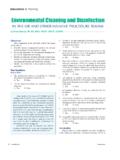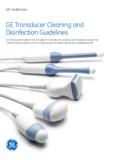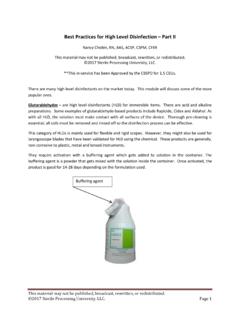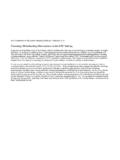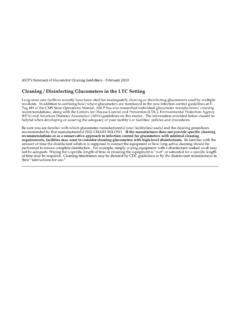Transcription of Viral Gastroenteritis NOROVIRUS - michigan.gov
1 _____ Viral Gastroenteritis NOROVIRUS Guidelines For Environmental cleaning And disinfection of NOROVIRUS _____ Noroviruses are a group of viruses that cause acute Gastroenteritis in humans. The symptoms of NOROVIRUS infection include nausea, vomiting, diarrhea, cramping, and low-grade fever. Noroviruses are transmitted through the fecal-oral route, either by consumption of fecally contaminated food or water, direct person-to-person spread, or environmental and fomite (inanimate object or substance that is capable of transmitting infectious organisms) contamination. Materials Needed: Disposable gloves, masks, eye protection or face shields, and gown or protective clothing Please don all materials before beginning cleaning procedure.
2 For questions about the above mentioned personal protective equipment, please see (Part ) General Warning: Chlorine bleach may damage fabrics and other surfaces. Please spot test area before applying to visible surface. This document contains information for: disinfection Specific Clean-up Procedures Food Service Establishments Healthcare/Hospital/Nursing Home Facilities Schools/Daycares Updated 01/05/09 Page 1 _____ disinfection (For non-visibly soiled areas - please refer to specific procedures for large spills) _____ Examples of items to disinfect.
3 Doorknobs, faucets, sinks, toilets, commodes, bath rails, phones, counters, chairs (including backs), tables, hand rails, elevator buttons, light switches, keyboards, mattress covers, aprons, uniforms, linens, bedding and ice machines. What works best: Chlorine bleach (sodium hypochlorite -NaOCl) Chlorine bleach concentrations and mixing instructions: 200ppm (parts per million) - 1:250 dilution Use for stainless steel, food/mouth contact items, toys 1 Tablespoon of bleach in 1-gallon water 1000ppm (parts per million) - 1:50 dilution Use for non-porous surfaces, tile floors, counter-tops, sinks, toilets 1/3-cup bleach in 1-gallon water 5000ppm (parts per million) - 1.
4 10 dilution Use for porous surfaces, wooden floors 1 and cup bleach in 1-gallon water Stability of Chlorine Bleach Open bottles of concentrated chlorine bleach will lose effectiveness after 30 days. Change bottles of bleach every 30 days for accurate concentrations. For disinfecting, use an unopened bottle of chlorine bleach. Prepare a dilution of fresh bleach every day of use and discard unused portions. Updated 01/05/09 Page 2 Bleach dilutions clarified with household measurement terms Bleach Solution Dilution Exact Chlorine (ppm) Dilution approximate Household (ppm) Approximate Application - Concentrate 52,500 - 61,500 Concentrate 52,500 - 61,500 * Patient Care - 1:10 5,250 - 6,150 cups / 1 gallon ~6000 * Patient Care - 1:100 525-615 cup / 1 gallon ~600 * Patient Care 1.
5 200 263 1 tablespoon / 1 gallon <200 Dietary - 1:1000 53-62 1 teaspoon / 1 gallon ~50 Dietary The glossary in the CDC guidelines provides bleach dilutions using household measurementterms and equivalent parts per million (ppm) that can be used to translate recommendations foruse in the patient care setting for environmental decontamination after cleaning , , forClostridium difficile. Premier s Safety Institute has expanded the information to include the useof chlorine bleach as a sanitizing agent in dietary settings consistent with EPA Gov tregulations (21 CFR Part 178).
6 Please see references on page 10. Other effective disinfectants A phenolic environmental disinfectant (Lysol or Pinesol ) may be effective, but may require a concentration of 2-4X the manufacturer s recommendation. The use of this product at the higher concentration may pose a significant health risk to children, workers, pets or yourself. Use extreme caution when using these products. Please read the manufacturer s warning. Environmental Protection Agency (EPA) -registered disinfectants Note: Some of these products now include quaternary ammonia-based disinfectants but in combination with alcohols. These claims of effectiveness are based on in-vitro studies usually using feline calicivirus; field effectiveness in the context of outbreaks has not been evaluated.
7 Updated 01/05/09 Page 3 EPA s Registered Antimicrobial Products Effective Against NOROVIRUS : NOT ALL DISINFECTANTS SHOWN ON EPA LIST ARE APPROVED FOR USE IN FOOD FACILITIES. ** Please see Food Service Establishments Section beginning on page 5. _____ Health Concerns with using Chlorine Bleach _____ Mixing hazards USE ONLY IN WELL-VENTILATED AREAS. Adverse effects of inappropriate mixtures of household cleaners usually are caused by prolonged exposure to an irritant gas in a poorly ventilated area.
8 The most common inappropriate mixtures of cleaning agents are bleach with acids (like vinegar) or ammonia (Windex ). Potential irritants released from such mixtures are chlorine gas, chloramines, and ammonia gas. Health hazards Chlorine bleach is corrosive and irritating to all mucosal tissue, skin, eyes and upper and lower respiratory tract. Avoid spray bottle application with any disinfectant. However, pour or pump bottles that do not produce aerosols are highly recommended. Personal protective equipment Disposable gloves, masks, eye protection or face shields, and gown or protective clothing Environmental cleaning using a more concentrated disinfectant will require a heavier duty glove than a simple non-sterile latex/vinyl glove.
9 Updated 01/05/09 Page 4 _____ Specific Clean-up Procedures _____ For cleaning large spills of vomitus or stool, a two-step process should be used. Put on personal protective equipment before cleanup as specified in the CDC document: 1. Pre- cleaning of visible/organic debris with absorbent material (double layer and placed in a plastic bag to minimize exposure to aerosols) should precede the disinfection process. 2. Liberally disinfect area and objects surrounding the contamination with an appropriate environmental disinfectant (multiple applications may be required).
10 *Ensure appropriate dilution and contact times for the appropriate environmental disinfectant. Hard surfaces Disinfect with bleach, rinse with water if food preparation area. Carpet / Upholstered Furniture Visible debris should be cleaned with absorbent material (double layer) and placed in a plastic bag to minimize exposure to aerosols - disinfecting with bleach may discolor carpet steam clean (heat inactivation) 158 F for 5 minutes or 212 F for 1 minute for complete inactivation. Linens / clothing / textiles If soiled, vomit or stool should be carefully removed to minimize aerosols. Keep contaminated and uncontaminated clothes separated.










